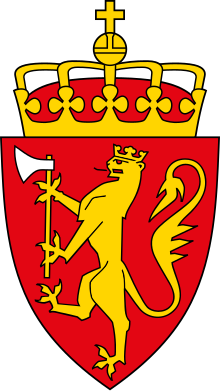Norwegian heraldry

Norway's national arms are among the world's oldest national arms still in use. Official drawing of 1992 by Sverre Morken.
|
|
| Heraldic tradition | German-Nordic |
|---|---|
| Governing body | King |
Norwegian heraldry has roots in early medieval times, soon after the use of coats of arms first appeared in continental Europe. Some of the medieval coats of arms are rather simple of design, while others have more naturalistic charges. The king-granted coats of arms of later times, were usually detailed and complex. Especially in the late 17th century and the 18th century, many ennobled persons and families received coats of arms with shields containing both two and four fields, and some even with a heart shield above these.
There are very few civic arms dating from before 1900, and the main part of today's governmental and civic arms are from the last decades of the 20th century. Today the public arms are popular in Norway and they are used quite much by the official authorities.
The Norwegian Heraldry Society is a private heraldic organisation.
Coats of arms in early medieval times were quite simple and of a rather basic design, when they were to be used in tournaments and other battles. The eldest Norwegian personal arms are known only from seals of the late 13th and the early 14th centuries. Most of the arms in the seals are not simple and have several charges combined, e. g. a griffin holding a bird (Bjarne Erlingsson 1288), two crossed axes and a fleur-de-lis (Jon Kollr 1297), and a fleur-de-lis between two roses on a fess (Baron Snare Aslaksson 1303).
The Dano-Norwegian union kings started to grant nobility and personal arms in the 15th Century. In the late 17th Century and during the 18th Century, many ennobled persons were granted arms with shields having two and four fields (e.g. Peter Tordenskiold), a few even with an escutcheon over all (e.g. Ludvig Holberg) and some with two supporters (e.g. Bernt Anker).
Arms were self-assumed in Norway and not a privilege for nobles. When nobility was granted by the union kings, even new arms were granted, often being the ennobled person's former arms with some additional charges (e.g. Herman Løvenskiold in 1739). Many of the ennobled person had direct influence on their new arms, especially those who paid a considerable amount of money to the king himself for the ennoblement (e.g. Gyldenkrantz).
...
Wikipedia
